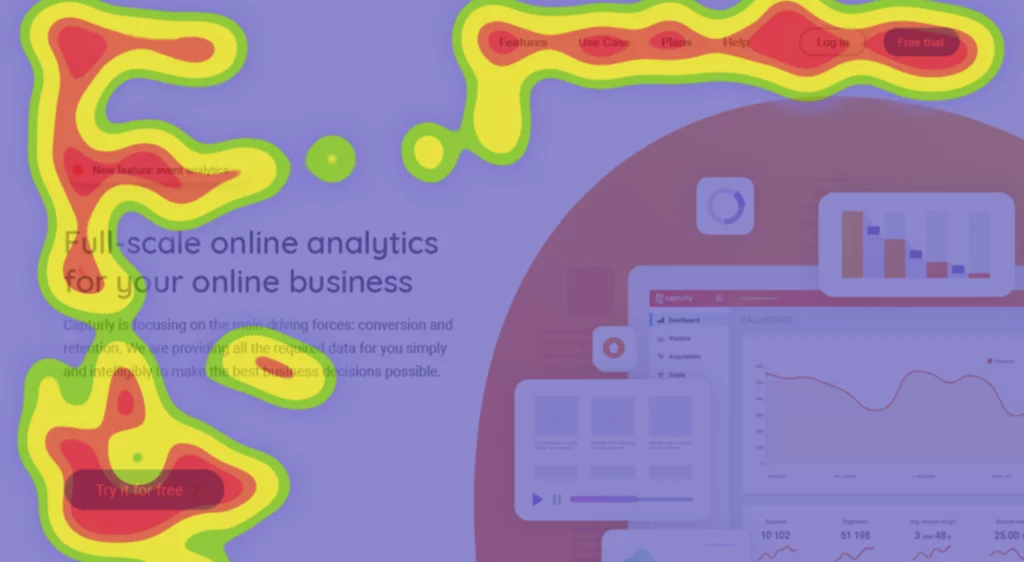Understanding how visitors interact with a website is done using a technique called website heatmap analysis. By tracking the clicks, taps, and scrolling of website visitors, heatmap analysis allows website owners to see which parts of their site are most popular, and which areas need improvement.
The benefits of website heatmap analysis
One of the key benefits of heatmap analysis is that it provides valuable insights into user behavior that can be used to improve website design, navigation, and content. Improving all this will ultimately lead to better customer experience management.
For example, if a heatmap shows that many users are clicking on a certain button or link, it may indicate that the button or link is not prominently displayed or easily accessible. In this case, the website owner can make changes to improve the visibility of the button or link, making it easier for users to find and use.
The ability to pinpoint parts of a website that consumers are finding confusing or frustrating is another advantage of heatmap analysis. For example, if a heatmap shows that many users are clicking on the wrong button or link, it may indicate that the button or link is not clearly labeled or that the layout of the site is confusing. In this case, the website owner can make changes to improve the labeling or layout of the site to reduce confusion and improve the user experience.
Heatmap analysis can also identify areas of a website that are underperforming. For example, if a heatmap shows that users are not scrolling down to the bottom of a page, it may indicate that the content at the bottom of the page is not engaging or relevant to the user.
The website owner can make changes to improve the content or layout of the page to encourage users to scroll down and engage with the site.

Types of heatmaps
The examination of website heatmaps may be done using a variety of tools and methods. Some popular tools include:
- Click heatmaps: These heatmaps track the location of clicks on a website, allowing website owners to see which areas of the site are getting the most clicks and which areas are getting the least clicks.
- Scroll heatmaps: These heatmaps track how far down page users are scrolling, allowing website owners to see which areas of the site are getting the most views and which areas are getting the least views.
- Mouse movement heatmaps: These heatmaps track the movement of a user's cursor on a website, allowing website owners to see which areas of the site are getting the most attention and which areas are getting the least attention.
- Attention heatmaps: These heatmaps track which areas of a website users are looking at, allowing website owners to see which parts of the site are capturing user attention and which parts are not.
Why is it worth it to use in SEO?
Heatmap analysis is an essential tool for SEO, as it helps website owners understand how users interact with their site and identify areas that need improvement. By analyzing data from heatmaps, website owners can make changes to improve the design, navigation, and content of their site, making it more user-friendly and increasing the chances of ranking higher in search engine results.
One of the most important aspects of heatmap analysis is to make sure you are targeting the right audience. Make sure that you are tracking the right visitors, such as those who have landed on your site via organic search or a specific marketing campaign. This will give you a better understanding of how these visitors are interacting with your site, and what changes you need to make to improve their experience.
Another important aspect of heatmap analysis is to make sure you are tracking the right pages on your site. For example, if you are running an e-commerce site, it would be more beneficial to track the pages where your products are displayed, rather than your blog or about us page.

Why is it useful during conversion rate optimization?
One of the key ways that heatmaps can increase conversion rates is by identifying areas of a website that are causing confusion or frustration for users. For example, if a heatmap shows that users are clicking on the wrong button or link, it may indicate that the button or link is not clearly labeled or that the layout of the site is confusing. By making changes to improve the labeling or layout of the site, businesses can reduce confusion and improve the user experience, which can lead to higher conversion rates.
Heatmaps can also be used to identify areas of a website that are underperforming. By making changes to improve the content or layout of the page, businesses can encourage users to scroll down and engage with the site, which can lead to huge conversion rates.
Another way that heatmaps can increase conversion rates is by helping businesses understand how users navigate their sites. By tracking user clicks and taps, heatmaps can provide valuable insights into how users are finding and accessing the different pages and features of a site. This information can be used to improve the navigation and layout of a site, making it easier for users to find what they are looking for, which can lead to higher conversion rates.
Heatmaps can also be used to identify areas of a website that is not getting enough attention. If a heatmap shows that many users are not looking at a particular section of a page, it may indicate that the section is not engaging or relevant to the user.
Another way heatmaps can increase conversion rate is by providing valuable insights into users' attention on a website. By tracking the movement of a user's cursor, mouse movement heatmaps can provide valuable insights into which areas of the site are capturing the user's attention and which parts are not.
This information can be used to improve the design and layout of a site, making it more engaging and capturing more attention, which can lead to increased conversion rates.
In conclusion, website heatmaps are a powerful tool for businesses looking to increase their conversion rate. By providing valuable insights into user behavior, heatmaps can help businesses identify areas of their site that need improvement and make changes to improve the user experience, which can lead to higher conversion rates.
Additionally, by tracking attention, businesses can make their site more engaging, making it more likely for users to convert. It's important to use the right tools, like A/B testing, to validate the changes before making it live on the website.
Heatmap tools in UX development
Website heatmaps are a powerful tool for businesses looking to improve the user experience (UX) on their website. By tracking user behavior on a website, heatmaps provide valuable insights into how users interact with a site, and which areas need improvement.
One of the key ways that heatmaps can increase website UX is by identifying areas of a website that are causing confusion or frustration for users. A heatmap tool can show how many visitors are clicking on the wrong button or link, it may indicate that the button or link is not clearly labeled or that the layout of the site is confusing.
Heatmaps can also be used to identify areas of a website that are underperforming.
Another way that heatmaps can increase website UX is by helping businesses understand how users navigate their sites. By tracking user clicks and taps, heatmaps can provide valuable insights into how users are finding and accessing the different pages and features of a site. This information can be used to improve the navigation of a site, making it easier for users to find what they are looking for, which can lead to higher engagement and better user satisfaction.
Heatmaps can also be used to identify areas of a website that is not getting enough attention. Another way heatmaps can increase website UX is by providing valuable insights into users' attention on a website. By tracking the movement of a user's cursor, mouse movement heatmaps can provide valuable insights into which areas of the site are capturing the user's attention and which parts are not. This information can be used to improve the design of the website, making it more engaging and capturing more attention.
Website heatmaps are a powerful tool for businesses looking to improve the user experience (UX) on their website. By providing valuable insights into user behavior, heatmaps can help businesses identify areas of their site that need improvement and make changes to improve the user experience.
Additionally, by tracking attention, businesses can make their site more engaging, making it more likely for users to have a positive experience on the website.
Conclusion
In conclusion, website heatmap analysis is an essential tool for businesses looking to improve their website's performance. By tracking user behavior on a website, heatmaps provide valuable insights into how users interact with it, and which areas need improvement. By making changes to improve the design, navigation, and content of a site based on the insights provided by heatmaps, businesses can improve the user experience, increase conversion rates, and optimize their website for search engine rankings. We recommend using it at regular intervals.

